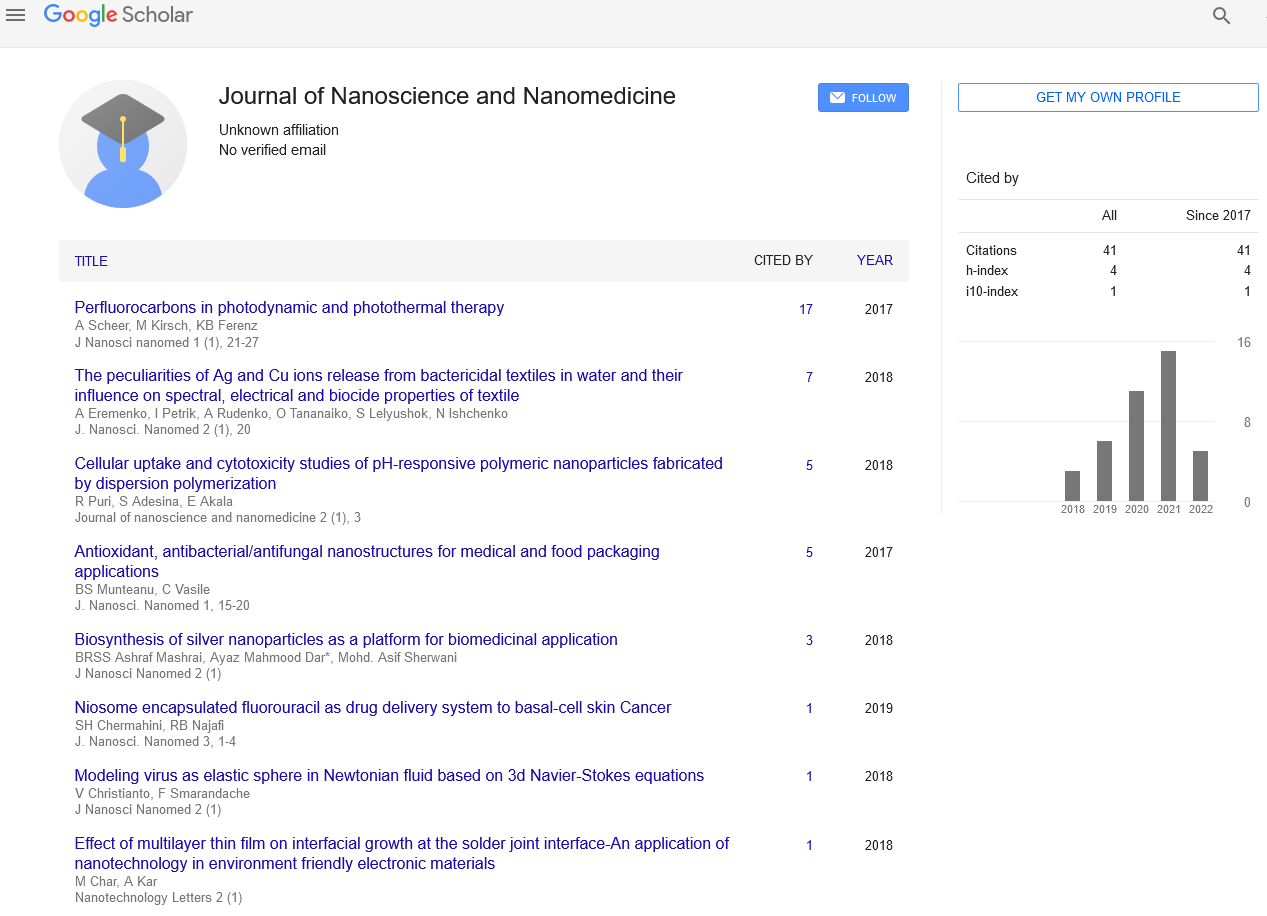Effect of Nanomaterials causing Nanotoxicity in Skin Cosmetics
Received: 22-Oct-2020 Accepted Date: Oct 24, 2020; Published: 12-Nov-2020
This open-access article is distributed under the terms of the Creative Commons Attribution Non-Commercial License (CC BY-NC) (http://creativecommons.org/licenses/by-nc/4.0/), which permits reuse, distribution and reproduction of the article, provided that the original work is properly cited and the reuse is restricted to noncommercial purposes. For commercial reuse, contact reprints@pulsus.com
Abstract
Nanomaterials and nanoparticles with harmful chemicals are damaging the skin of people who are sensitive towards this cosmetic and such nano cosmetics can lead to skin toxicity and this effect of toxicity with nano products are referred as nanotoxicity. These cosmetics can protect the skin from radiation and in the same case it leads to skin burns due to high dose of chemicals.
Keywords
Nanomaterials, Nanoparticles, Nanotoxicity, Skin burns, Chemicals.
Introduction
The present situation of all our entire world, humans are more prone to various skin disease with several skin products such as skin cosmetics. Mainly people with different age groups such as adults and young would like to express them self with a good and attractive manner this can boost up their confidence in presenting them self in a better way and people with any age group are trying to look attractive and would like to cover their age and for this purpose they are investing more money for buying a new different variety of cosmetics, especially women try to look more beautiful, young day by day than men. There are different varieties of cosmetic products launching every day in the global market with huge investments. Cosmetics are highly demandable with their brands and their quality and safety. In some cases, cosmetics may lead to skin toxicity [1].
Cosmeceuticals are the products, which hideaway between active pharmaceutical ingredient and cosmetics. It is exploited as cosmetics because it claims to affect appearance but also has a therapeutic effect. There is no classification of cosmeceuticals by the Food and Drug Administration, instead skin experts and professionals used this term to promote purchasing of cosmetic products especially antiaging and sunscreen products. A leading product from Cosmeceuticals are Nanocosmeceuticals [2-3].
Nanomaterials having one primary dimension of less than 100 nanometers, based on this Nanotechnology in recent trending world this development is very high and produces health and safety effects. A nanoparticle is a “particle having dimensions on the nanoscale,” i.e., particle size below 100 nm. As per cosmetology, it is considered that smaller the particle size, more ready will be the absorption and efficient will be the damage repair [4]. Thus, the term was coined as “ nanocosmeceuticals. ” Nanoparticles are divided into combustion-derived nanoparticles like diesel soot, these are manufactured as a carbon nanotube and these are naturally occurring from volcanic eruptions and atmospheric chemistry etc. Typical nanoparticles are some particles that are titanium dioxide, alumina, zinc oxide, carbon black, carbon nanotubes, and buckminsterfullerene [5].
A widely used Nanocosmeceuticals for skin purpose and for hair purpose and they are used in shampoos, conditioners, dandruff, hair damage, hair sprays, jells etc. This can also be used for nails, lip care products used in such conditions like wrinkles, photoaging, hyperpigmentation creams are widely used now a days [6]. Novel nanocarriers like liposomes, niosomes contain vitamins or antioxidants and carriers for unsaturated fatty acids, nanoemulsions such as conditioners or lotions, microemulsion, solid lipid nanoparticles, nanostructured lipid carrier, nanoparticles contains body firming lotion, toothpastes, soaps, face creams, bronzer, exfoliant scrub, eye liner, and styling gel, nanocapsule-based cosmetic product, nanocrystals, dendrimers, fullerenes, nanosomes. and nanospheres have replaced the usage of conventional delivery system [7]. These nanocarriers have a great advantages of enhanced skin penetration, controlled and sustained drug release, site specific targeting, higher stability, and high entrapment efficiency.
Nanotoxicology is referred as toxicity of nanomaterials. Due to their quantum size effects a large surface area to volume ratio, nanomaterials have unique properties compared with their larger counterparts that affect their toxicity [8]. This toxicity may lead to inflammation, fibrosis, and carcinogenicity and produces some harmful effects on the skin and lead to skin cancer. This toxicity can also lead to damage some internal organs like lung tissues, blood brain barrier etc. In some cases, nanoparticles can be absorbed, swallowed, inhaled through skin can causes skin burn and medical care is compulsory and should be isolated [9-10].
Conclusion
Nanocosmetics are safe and this product can be encouraged for sensitive skin and in some cases due to sever exposure of sun or due to some harmful rays can burn the skin and leads to toxicity. To avoid such harmful effects precautions should be taken to protect the skin and be protective from harmful radiation.
REFERENCES
- Nagaich U. Nanocosmeceuticals: A boon to personal care products. J Adv Pharm Technol Res. 2016;7(1):1.
- Kaul S, Gulati N, Verma D et al. Role of Nanotechnology in Cosmeceuticals: A Review of Recent Advances. J Pharm Cairo. 2018.
- Prashant DS. Nano-systems for Cosmetic, and their Nanotoxicity and Regulatory Issues. BAOJ Nanotech. 2017;3(3):1-11.
- Borm PJA. Particle toxicology: from coal mining to nanotechnology. Inhal Toxicol. 2002;14(3):311–24.
- Zhang QW, Kusaka Y, Sato K et al. Differences in the extent of inflammation caused by intratracheal exposure to three ultrafine metals: role of free radicals. J Toxicol Env Heal. 1998;53(6):423–38.
- Schlesinger RB. Toxicological evidence for health effects from inhaled particulate pollution: does it support the human experience. Inhal Toxicol. 1995;7(1):99–109.
- Oberdorster G, Ferin J, Lehnert BE. Correlation between particle-size, in-vivo particle persistence, and lung injury. Environ Health Persp. 1994;102(5):173–179.
- Holsapple MP, Farland WH, Landry TD, et al. Research strategies for safety evaluation of nanomaterials, part II: Toxicological and safety evaluation of nanomaterials, current challenges, and data needs. Toxicol Sci. 2005;88(3):12–17.
- Linkov I, Satterstrom FK, Corey LM. Nanotoxicology and nanomedicine: making hard decisions. Nanomedicine: Nanotech Bio and Med. 2008;4(2):167–71.
- Hyuk Suh W, Suslick SK, Galen SD et al. Nanotechnology, nanotoxicology, and neuroscience. Pro Neurobiol. 2009;87(3):133–70.





